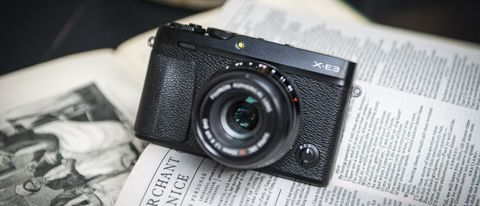Why you can trust TechRadar
Build and handling
- Magnesium top and bottom plates
- No weather sealing
- Weighs 337g
While the X-E2 and X-E2s followed much the same design as the X-E1, the Fujifilm X-E3 is markedly different. Noticeably smaller than the X-E2s, the X-E3 takes the crown as the smallest X Series camera with a viewfinder currently available. Partner it with a couple of Fujifilm's neat f/2 primes, like the 23mm or 35mm, and you've got a great little camera system.
Don't think the reduction in the X-E3's footprint has compromised its handling; there's a decent handgrip that's pretty much identical in size to the one on its predecessor, while the raised thumb rest on the rear of the camera makes it incredibly comfortable to hold one-handed.
As we've come to expect with X Series cameras, the fit and finish are very nice. It may not be weather-sealed, but the magnesium alloy top and bottom plates, along with the machined dials, give the X-E3 a lovely premium feel.



With the X-E3's body shrinking compared to the X-E2s, the built-in flash has had to be sacrificed, to be replaced by a pocket-sized hotshoe-mounted flash. Otherwise, the top plate of the X-E3 remains the same as on the X-E2, with shutter speed and exposure compensation dials complementing the shutter button and small function button.
The shutter speed dial offers settings running from 1 to 1/4000 sec plus Bulb, Time and Automatic, with the exposure compensation dial running from -3 to +3EV. As we've seen with other X Series cameras, there's also now a ‘C’ setting on the dial, which lets you set compensation up to ±5EV using the camera's new front command dial.
A subtle change is the arrival of a small rocker switch round the shutter speed dial, with the option to set the camera to a full Auto mode – perfect for new users who just want to start snapping and without getting bogged down wondering which aperture or shutter speed to use.
The four-way controller on the X-E2 has completely disappeared on the X-E3
The biggest changes, though, are at the rear of the X-E3, with a much more streamlined layout than we've seen previously.
The display now butts up to the left edge of the camera, while the four-way controller from the X-E2 has disappeared. Instead, you can use the touchscreen control to flick right, left, up or down with your thumb to access four different functions or settings, which can be tailored to your preference in the menu.
The X-E3 also benefits from the focus lever we first saw on the X-Pro2, enabling you to toggle quickly to the desired AF point, while you can also use it to navigate the camera's menu system if you prefer that to the touchscreen.
As we've seen with other X Series cameras, the level of customization impresses, while the overall handling is very satisfying. The absence of a four-way controller isn't an issue, while there are plenty of body-mounted controls to make this a quick camera to operate.
Autofocus
- 325-point AF
- Eye-detection AF
- 5 AF-C presets
The Fujifilm X-E3 uses the same 325-point AF system as the X-T20. This is broken down into 169 phase-detect points set out in a grid of 13 x 13 in the middle of the frame, with an additional two grids of 6 x 13 contrast-detect points on either side to make up the 325 focusing points.
That's if you're using the X-E3's single-point AF mode. When you opt for Zone or Wide/Tracking, coverage drops to a still-decent 91-point AF arrangement. In this instance, there's a central 7 x 7 grid of phase-detect points.
For static subjects, focusing is swift – the X-E3 happily locked onto a variety of subjects under a range of lighting conditions, while switching to continuous AF saw a welcome improvement in focusing accuracy over the X-E2.
This is thanks to a new AF algorithm that takes three parameters into consideration. These are Tracking Sensitivity (how long the camera waits before switching focus), Speed Tracking Sensitivity (determines how sensitive the tracking system is to changes in subject speed) and Zone Area Switching (whether bias is towards the center, auto or front).
With five presets to choose from depending on how erratically your subject is moving, AF tracking is much improved. Focusing speed could be a bit quicker (it's not quite a much for the likes of Sony's Alpha A6300), but it's a very solid performer.
Current page: Build, handling and AF
Prev Page Introduction and key features Next Page Performance and image qualityPhil Hall is an experienced writer and editor having worked on some of the largest photography magazines in the UK, and now edit the photography channel of TechRadar, the UK's biggest tech website and one of the largest in the world. He has also worked on numerous commercial projects, including working with manufacturers like Nikon and Fujifilm on bespoke printed and online camera guides, as well as writing technique blogs and copy for the John Lewis Technology guide.

